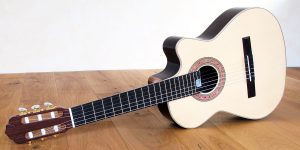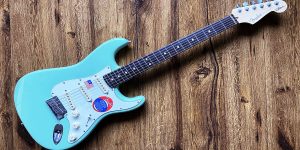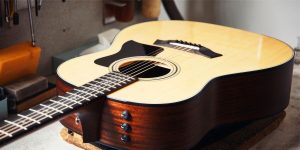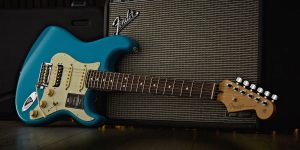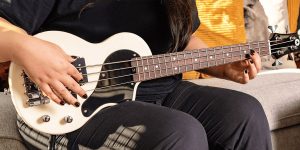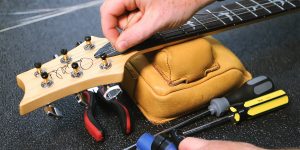Headless guitars, or guitars without headstock, have made incredible strides in recent years, demonstrating their growing popularity among musicians. These unique instruments, a revelation in terms of portability and performance, have emerged as the go-to choice for many artists.
In this article, I will explore the various advantages that make headstock-less guitars stand out. Whether you’re a seasoned musician or a music enthusiast, understanding the possibilities of headless guitars can open new horizons in musical expression and experience.
What are headless guitars?

Headless guitars, essentially, are innovative musical instruments devoid of the traditional headstock found on conventional guitars. This unusual design places the tuning machines at the body of the guitar, resulting in a more compact and balanced structure, ideal for musicians on the go.
The inception of the headless guitar traces back to the late 20th century, with brands like Steinberger pioneering this groundbreaking design, and it has evolved substantially since, adapting to the diverse needs and aesthetics of modern musicians.
Nowadays, there’s a broad spectrum of headless guitars available, accommodating various musical genres and playing styles:
- Electric headless guitars: Perfect for a plethora of music genres, from rock to jazz, offering an array of styles and sound profiles.
- Acoustic headless guitars: Offering classical acoustic sound in a more portable and manageable size, suitable for unplugged sessions and intimate performances.
- Bass headless guitars: A boon for bassists, these instruments are compact yet deliver powerful low-frequency tones essential in rhythm sections.
The evolution and versatility of headless guitars’ design are manifested in the myriad of styles and configurations available, ranging from sleek and minimalist to intricate and elaborate designs, allowing musicians to find an instrument that resonates with their personal aesthetic and musical inclination.
With such a variety of styles and designs, musicians, regardless of their preferred genre, can take advantage of guitars with no headstock. This makes it incredibly easy and comfortable to use your instrument anywhere and to play virtually any genre.
Advantages of headless guitars

These models, known for their striking modern aesthetics and revolutionary design, have become noteworthy for the plethora of advantages they offer:
Improved portability:
- Compact design for travel: The absence of a headstock renders headless guitars extremely compact and travel-friendly, ideal for touring musicians and hobbyists alike.
- Reduced weight: Their streamlined construction typically weighs less than traditional guitars. This weight reduction is a blessing for musicians during lengthy performances, reducing fatigue and enhancing playability.
Ergonomic benefits:
Headless guitars are often hailed for their ergonomic design, ensuring superior play comfort.
- Body contour and balance: The thoughtful contouring and balanced design facilitate easy access to higher frets and alleviate strain on the musician’s body, allowing for prolonged playing sessions without discomfort.
Modern aesthetics and innovation:
- Unique body shapes and finishes: This shape of the instrument is not only comfortable and ergonomic, but it is also visually appealing. Whether you’re on stage or at a barbecue with friends, you and your guitar will be the center of attention.
Versatility and sound:
- Suitable for various genres: Headless guitars are versatile and adapt well across musical genres, from rock and metal to jazz and fusion.
- Examples of artists: Renowned musicians like Allan Holdsworth and David Gilmour have embraced headless guitars, showcasing their versatility across diverse musical landscapes.
This combination of portability, ergonomic benefits, innovative aesthetics, and sound versatility make headless guitars an appealing choice for modern musicians looking to elevate their musical expression and stage presence.
Are headless guitars worth the investment?
Investing in a headless guitar, a revolutionary guitar without tuning pegs, can indeed be a wise decision, particularly for individuals who value portability and modern aesthetics in their instruments. If you find yourself frequently traveling or in need of a guitar that’s effortless to transport, the compact design of a headless guitar emerges as a significant advantage.
Additionally, many musicians are drawn to the unusual design of headless guitars, allowing them to stand out both in sound and appearance. In essence, if portability, style, and playability align with your musical needs, headless guitars are undoubtedly a valuable investment.


